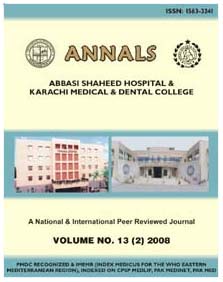
| |
| Home |
| Editorial Staff |
| Instruction to Authors |
| Journal-Issues |
| Policy |
| Copyright |
| INCIDENCE OF UNDESCENDED TESTES IN
ABBASI SHAHEED HOSPITAL
WAQAR A. KHAN*, M. JAMALUDDIN**, S. M. ABBAS** ABSTRACT Objective: To assess the different clinical presentation and the relation between histopathological changes seen in undescended testis at age of presentation. Design & Duration: Prospective and descriptive study done during the period from July 2003 to June 2005. Setting: In Surgical Unit-1, Abbasi Shaheed Hospital & Karachi Medical & Dental College, Karachi. Patients: 60 patients of undescended testes who were admitted through out patient department of different surgical units were included in this study. Methodology: This study was carried out for a period of two years in Surgical Unit-1, Abbasi Shaheed Hospital in which about 60 patients were included who were admitted in different surgical units. All patients were admitted through out patient department after proper diagnosis and investigations especially ultrasonography of abdomen and pelvis and in few cases Computed Tomographic scan and Magnetic Resonance Imaging were also done to locate the testes. In cases of bilateral undescended testes, hormonal assays of human chorionic gonadotrophin, Follicle Stimulating Hormones and Leutinizing Hormone were also carried out. After admission patients were prepared for surgery and orchiopexy was done in patients who were below 12 years of age while orchidectomy was done in patients who were above 12 years of age and also in patients who could not be followed up due to poor patient compliance. Tissue biopsy was done in all patients of orchiopexy. Biopsy was taken from lower pole of testis in case of orchiopexy while in orchidectomy the whole specimen of testis was sent for histopathology. Patients were followed up for two years. Results: Among 60 patients, most of the patients were between ages of 03-12 years (41.66%), while the youngest patient was one and half years old and 03 patients (05%) were more than 25 years old. About 34 patients (56.66%) had right sided undescended testes, 18 patients (30%) had left sided and 06 patients (10%) had bilateral undescended testes while two patients (03.33%) had intra-abdominal testes in them and only two patients had Ectopic testes in them (03.33%). The most common clinical presentation (complain) was inguinal hernia 39 cases (65.00%), pain was next complain in this study 18 cases (30.00%), two patients presented with hydrocele (03.33%) while only one patient presented with testicular tumor (01.66%). The most common changes examined histopathologically include closely packed semineferous tubules lined by sertoli cells only, germ cell atrophy, intervening area between semineferous tubules showed leydig cells hypoplasia and evidence of fibrosis. Older the age of the patient more atrophic the testis appeared gross during surgery which relates histopathologically also. Orchidectomy was done in atrophic testes. One case of testicular tumor was diagnosed in which orchidectomy performed and showed malignant mixed germ cells tumor. Conclusion: Through this study it is concluded that the most common age of presentation was 03-12 years with one and half years was the youngest and 30 years was the oldest in this study. Right side was the common side of presentation. Almost all cases were benign except one case which was malignant. Histopathological changes were more marked with increasing age of the patient. Keywords: Undescended testis, orchiopexy, orchidectomy,
|
For Full text contact to:
|
|
1
|

Copyright © 2009 Abbbas Shaheed Hospital and Karachi Medical & Dental College.
All rights reserved.
Designed & Developed by: Creative Designers